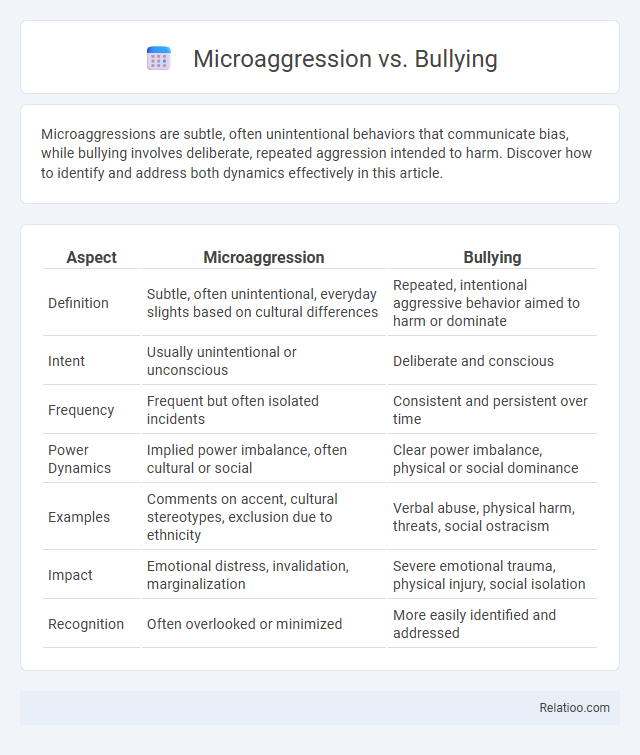Microaggressions are subtle, often unintentional behaviors that communicate bias, while bullying involves deliberate, repeated aggression intended to harm. Discover how to identify and address both dynamics effectively in this article.
Table of Comparison
| Aspect | Microaggression | Bullying |
|---|---|---|
| Definition | Subtle, often unintentional, everyday slights based on cultural differences | Repeated, intentional aggressive behavior aimed to harm or dominate |
| Intent | Usually unintentional or unconscious | Deliberate and conscious |
| Frequency | Frequent but often isolated incidents | Consistent and persistent over time |
| Power Dynamics | Implied power imbalance, often cultural or social | Clear power imbalance, physical or social dominance |
| Examples | Comments on accent, cultural stereotypes, exclusion due to ethnicity | Verbal abuse, physical harm, threats, social ostracism |
| Impact | Emotional distress, invalidation, marginalization | Severe emotional trauma, physical injury, social isolation |
| Recognition | Often overlooked or minimized | More easily identified and addressed |
Understanding Microaggressions: Definition and Examples
Microaggressions are subtle, often unintentional, comments or behaviors that convey prejudiced attitudes toward marginalized groups, differing from overt bullying, which involves deliberate and repeated aggressive actions. Examples include seemingly innocuous remarks like "You speak English so well," implying foreignness, or consistently mispronouncing someone's name, which can undermine a person's identity and cause emotional harm. Understanding microaggressions is crucial for fostering inclusive environments that recognize the impact of these subtle biases compared to the more direct harm caused by bullying.
What Constitutes Bullying? Key Characteristics
Bullying constitutes repeated aggressive behavior intended to harm or intimidate others physically, verbally, or emotionally, often involving a power imbalance. Key characteristics include intentionality, repetition, and the creation of a hostile environment that can severely impact Your mental and emotional well-being. Unlike microaggressions, which are subtle and often unintentional slights, bullying is overt and persistent, clearly aimed at dominating or controlling the victim.
Microaggression vs Bullying: Core Differences
Microaggression involves subtle, often unintentional, behaviors or comments that convey prejudice or discrimination, typically targeting marginalized groups, whereas bullying is characterized by repeated, intentional acts of aggression aimed at harming or intimidating an individual. Microaggressions tend to be indirect and can include micro-invalidations or micro-assaults, while bullying is overt with clear power imbalances and aggressive intent. Understanding these core differences is critical for developing effective strategies in educational and workplace environments to address and reduce harm.
Psychological Impact: Microaggressions Compared to Bullying
Microaggressions are subtle, often unintentional, verbal or behavioral slights that can accumulate and cause significant psychological distress, including anxiety and diminished self-esteem. Bullying involves overt, repeated aggressive behavior intended to harm, leading to more immediate and intense psychological effects such as depression, trauma, and social withdrawal. Understanding how microaggressions and bullying differently impact your mental health is crucial for recognizing the nuanced ways these behaviors affect emotional well-being.
Intentionality: Unpacking the Motives Behind Each
Microaggressions often stem from unconscious biases and subtle, unintentional slights, whereas bullying involves deliberate actions aimed at intimidating or harming someone. Understanding the intentionality behind microaggressions, bullying, and intentional aggression helps you differentiate between accidental harm and purposeful hostility, guiding appropriate responses. Recognizing these motives is crucial for creating supportive environments that address both unintentional offenses and intentional aggression effectively.
Recognizing Subtle vs Overt Behaviors
Microaggressions are subtle, often unconscious behaviors or comments that convey prejudice or discrimination, while bullying involves overt, intentional acts of aggression designed to intimidate or harm. Recognizing microaggressions requires understanding nuanced verbal or nonverbal cues that may seem minor but have significant psychological impact. Bullying is more easily identifiable due to its clear, repetitive hostile actions, whereas microaggressions demand sensitivity to underlying biases embedded in everyday interactions.
Contexts and Environments Where Each Occurs
Microaggressions frequently occur in everyday social or professional settings, often manifesting as subtle, indirect offenses rooted in implicit biases, such as workplace meetings or casual conversations. Bullying typically arises in more overt, power-imbalanced environments like schools, workplaces, and online platforms, involving repeated aggressive behavior intended to intimidate or harm. Microassaults, a category of microaggressions, often take place in similar contexts as microinsults but are more explicit, such as intentional slurs or discriminatory actions in social or professional environments.
Strategies for Addressing Microaggressions
Addressing microaggressions requires creating safe environments where individuals can openly discuss their experiences without fear of retaliation or dismissal. Implementing training programs that increase awareness and empathy about implicit biases helps reduce unintentional harm and promotes inclusive behavior. Encouraging bystander intervention and establishing clear organizational policies ensures microaggressions are identified and addressed promptly, minimizing their long-term psychological impact.
Approaches to Prevent and Stop Bullying
Effective approaches to prevent and stop bullying involve establishing clear anti-bullying policies, promoting empathy through social-emotional learning programs, and encouraging bystander intervention strategies. Creating a supportive school culture where open communication is valued helps identify and address bullying behaviors promptly. Training staff and students to recognize differences between microaggressions and bullying enhances targeted responses, reducing harm and fostering inclusivity.
Building Inclusive Spaces: Reducing Harm from Both
Building inclusive spaces requires recognizing the subtle yet harmful impact of microaggressions alongside the overt damage caused by bullying. Implementing targeted training programs helps individuals identify microaggressive behaviors, fostering empathy and respect, while clear anti-bullying policies establish safety and accountability. Cultivating open dialogue and continuous feedback loops encourages a culture of inclusion, reducing harm and promoting psychological well-being for all community members.

Infographic: Microaggression vs Bullying
 relatioo.com
relatioo.com